Kynda class cruisers (1961-63)
 Groznyy, Admiral Fokin, Admiral Golovko, Varyag
Groznyy, Admiral Fokin, Admiral Golovko, Varyag
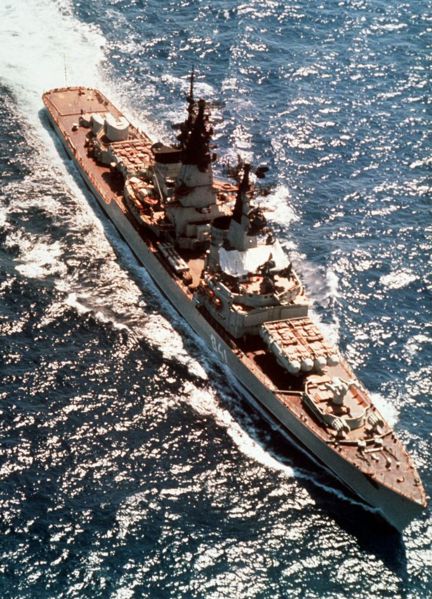
Kynda
The four ships of the Kynda class were the first Soviet missile cruisers. They were from the outset (1956) designed to destroy American aircraft carriers by other and more modern means than Stalin’s traditional attachment to conventional artillery. This position was very mush argued and pushed foward tirelessly by Admiral Kuznetsov. He wanted a technological edge to compensate for the lack of classic firepower. What was left of the Soviet Navy in WW2 has been destroyed during the conflict and the 1950s generation was still very much conventional. The missile, pioneered by German engineers notably during the last decade, was now clearly the way forward, rather than raining down shells on a distant target, more difficult to see beyond 40 km.
Under the rainbow
Soviet missile development started, notably for antiship missiles, at МКБ Радуга (Raduga Design Bureau or MKD Raduga), literraly “rainbow”. It was the fomer OKB-2, based at Dubla, near Moskow. Today it’s part of the huge Russian Tactical Missiles Corporation. Formely a division of the Mikoyan-Gurevich design bureau, it was made independent as an OKB (or design bureau) in March 1957; but started development of missile way before. In 1947, it started development of the KS-1 Komet (AS-1 “Kennel”), followed by the K-10S (AS-2 “Kipper”), much heavier, and mostly airborne. By default of a nuclear warhread, the 940 kg was reputed able to severely damage an aircraft carrier. Each TU-16 carried two under the wings and they were almost as large as a MiG-15. A whole serie of airborne antiship missiles were developed afterwards, the Kh/KSR airborne series, the ship-to-ship lineage was rather slim, with just the P-15 Termit (SS-N-2 “Styx”), and from 1984, the ramjet P-270/3M80 Moskit (SS-N-22 “Sunburn”).
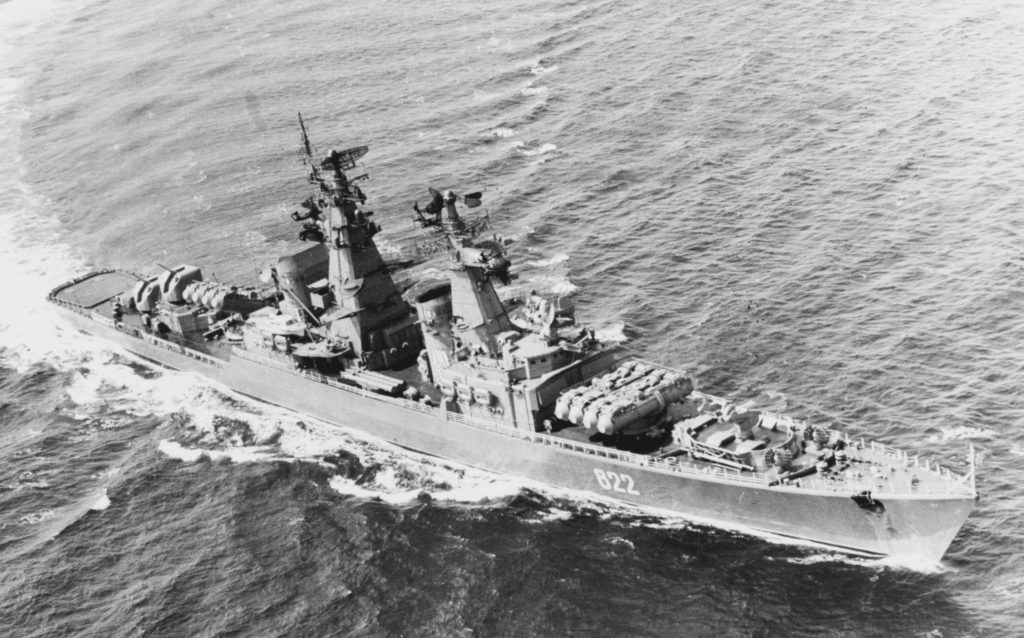
Genesis of the Kynda class cruisers
The appearance of the project 58 missile cruisers in the Soviet Navy resulted from the will of Soviet naval leadership to find an asymmetric weapon able to re-establish a balance. Design bureaus received a wealth to push R&D for nuclear energy and guided missile weaponry. Missiles were destined to compensate for the only response to USN Task Forces, coastal-based aircraft, easy to shot down. Above all, USN and NATO aircraft carriers and amphibious formations made for a prime target.
Work started on the future “Kreiser” in 1956. By December 6, 1956, the head of the Navy S. G. Gorshkov approved the defined tactical and technical requirements for a guided missile destroyer. Earlier in October development started on the Volna and P-35 air defense systems, which can be installed on the future ships as well, providing a welcome protection.
Development of project 58 was entrusted to TsKB-53 (Chief designer V. A. Nikitin) and the first draft was approved in September 1957, sanctioned by the Navy’s Shipbuilding Department order for further development prepared by March 1958.
The first batch’s blueprints stated “ships with jet weapons”, a vague wording highlighting the ambiguity of the classification. Its semi-experimental nature also reflected the attitude of the leadership and preferrence back then towards cruisers. From 1960, the mismatch between tactical objectives and armament was further discussed in the fleet’s hierachy and final classification of project 58 was stopped by 22, 1962. N. S. Khrushchev was then indeed paying a visit to Grozny, and the first successful missile firing took place. Therefore by November 4, 1962, the enthusiasm of the new leader made for a definitive classification as a “missile cruiser”. Blueprints were prepared to built no less than sixteen Project 58 cruisers, whereas eventually only four were built, one for each fleets (Baltic, Pacific, Arctic, Black sea). This was notably caused by a priority change, directed towards anti-submarine warfare.
Specifications of the Kynda class
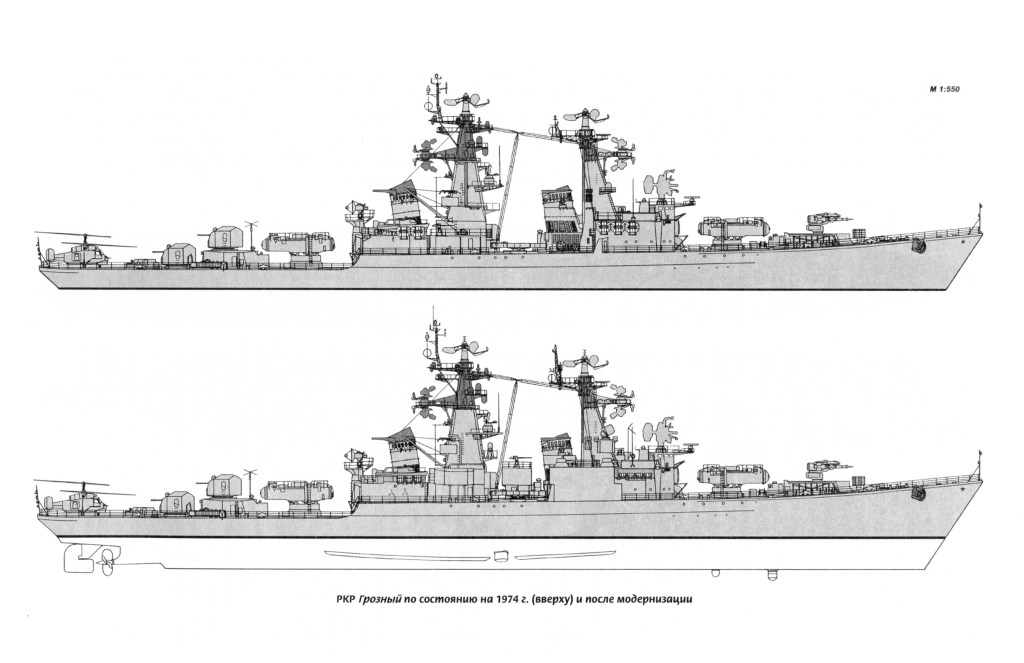
Differences between the ships before and after the 1980s refit. The most obvious are the four new Gatling-style guns mounted on a bay covering the sides of the forward bridge. Notice also a new antenna on the mainmast, new superstructure alongside the aft mast and added structure with AA gun in between masts and TT banks. Unknown origin, Pinterest.
Propulsion
The powerplant was a new system alike the Kashin-class, combining turbines powered by four supercharged boilers. Due to reduced hull size, this powerplant was “only” able to give these ships a speed of 34 knots. The arrangement combined a boiler and a turbine placed in echelon principle in two machine rooms. There was a great innovation as for the first time high-pressure boilers used a newly-developed turbocharged pressurization. The KVN-95/64 boilers made it possible to double the output while reducing consumption by 30% and increase the efficiency by 10%. It was made by conceding efficiency at small and medium speeds. Also this new arrangement allowed to reduce the exhaust temperature by 60%, reducing greatly the infrared silhouette of the ships.
TV-12 Steam turbines were used in turbo-gear assemblies and differed from Destroyer’s TV-8 turbines by offering 1/4 more power, with 35% less specific gravity and higher efficiency, but keeping the same dimensions. It was ideal for these rather small “cruisers”. The while machinery could be controlled remotely from pressurized cabins as well. Onboard electricity was obtained from two TD-750 turbogenerators (750 kW) connected to two DG-500 diesel generators (500 kW each), generating a 380 V three-phase alternating current.
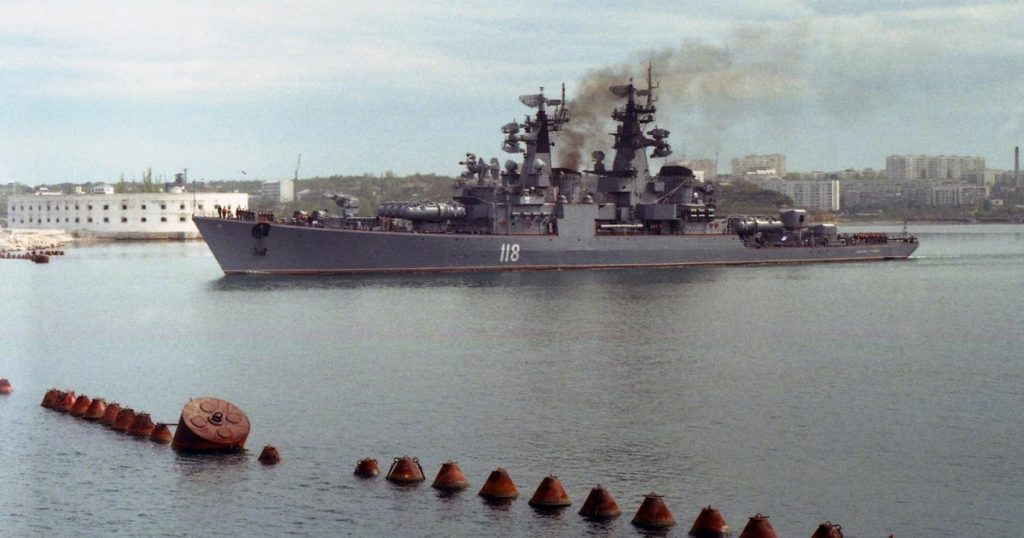
Project 58, 1997, VVK
Main armament of the Kynda class
While the ship’s power was innovative, above the machinery deck the ship was nothing short of revolutionary, entirely designed to be a missile carrier and operating platform. The idea was, to ensure maximum efficiency, to deliver a deadly “volley” of eight P-35 (NATO SS-N-3 Shaddock cruise missiles. They were long-range (250 nm) vectors, and their launching tube could be refilled by eight other vectors stored in back superstructure containers. In fact, the bridge was built above them. On paper this was a double volley of 24 vectors, which was formidable, but reloading operations took time and care in good sea conditions only. SS-N-3 mssiles could be loaded in addition with a tactical or conventional nuclear warhead. however their onboard radar was only good for the initial phase and they relied on their final course, to the guidance of a Tupolev Tu-95 “Bear-D”. This was in the end, a combined operation.
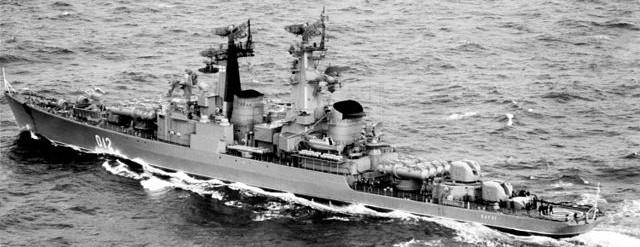
Cruiser Varyag in 1989
The P-35 anti-ship missile system was developed at OKB-52 (later Raduga design bureau), a version of the P-6 anti-ship missile developed for submarines. The P-35 was heavier, longer and larger, but did not possessed an air intake and conical body. The P35 was 9.8 m long for 86 cm in diameter and having a wingspan of 2.67 m, for an overall weight of 4200-4500 kg. It was down to 3800 kg wen hitting the target. It carried a 560 kg warhead, including a TNT load of 405 kg. One of fourth missile was given a tactical nuclear warhead. Altitude and speed settings were possible, either 400, 4000 and 7000 m high, and 100 to 300 km range, flying at 1.3 mach.
Guidance was done at first by the ship’s operator, and there was one was controlling each missile in homing mode, so eight operators total. The extra missiels were considered in fact as a reserve, not specifically to deliver two volleys, as confidence in these early guidance systems and operations was low, as well as accuracy at long distances. The operators followed their vector after launch by using Binom radar antennas, turned after some distance to a guiding radar, providing data to the operator, analyzing the radar image which still could send instructions in fight for correction courses. Four antennas for the Binom control system on board only made possible a four-missile salvo at a time. The remaining four still could be launched, but stayed in homing mode, so with much lower hit probability.
Each of the massive SM-70 launchers platform carried four tubes. They could rotate to 120° and elevate to 25° and take position in less than 90 seconds at a rate of 5°/sec. for traversing. To avoid the exhausts burning the superstructure or damaging the ship, it was to head perpendicular to the enemy. On paper it was sound, but the installation was heavy and complicated to operate and the Kynda were the only ships (with the kirivak class) to try this system in the Soviet Navy. Their weight could cause stability issues and was only possible on a still sea. Also, the eight spare missiles in their cells behind the launcher were difficult to operate on the high seas and the whole operation required a calm sea, for more than an hour. This preventing any efficient use in the North sea an Artctic, especially in Winters. Later, NATO experts concluded the ships could only perform two volleys of four but in a war situation, reloading time and conditions would have made the ship a prime target, likely to be destroyed by carrier aviation and missiles.
AA Armament of the Kynda class
Anti-aircraft defence was provided by a M-1 Volna missile system, a navalized version of the S-125 Neva and DP guns. NATO knew it was the SA-N-1 “Goa”. It was a short-range missile twin launcher, with sixteen vectors in reserve in two under-deck drum sets, but with very relative efficiency (as the range augmented). This was complemented by two AA gun plus four fast firing anti-missile guns.
M-1 Volna (“Wave”) V-600 SAM
The M-1 Volna air defense system two-frame launcher was located in the bow, in front of the SM-70 launcher. It could launch its two missiles every minute. They were guided by the “Yatagan” control system, a single-channel radar, providing guidance of either, or both missiles, but at one target. There was also a sharp decrease in firing accuracy over long distances. The B-600 missile was 5.88 m long, weighted 923 kg and carried a 60 kg warhead with a proxiity fuse, as a flight speed of 600 m/s. Range was 4000-15,000 over the sea and up to 100-10,000 meters in altitude.
Despite its limitation this system was considered reliable enough and was soon in widespread use on many ships. The mssiles were in addition modernized over time, and managed to remain in service until the 2000s. In the mid-1960s, improvements were made through training to reach proficiency against sea targets within the radio horizon, just in case.
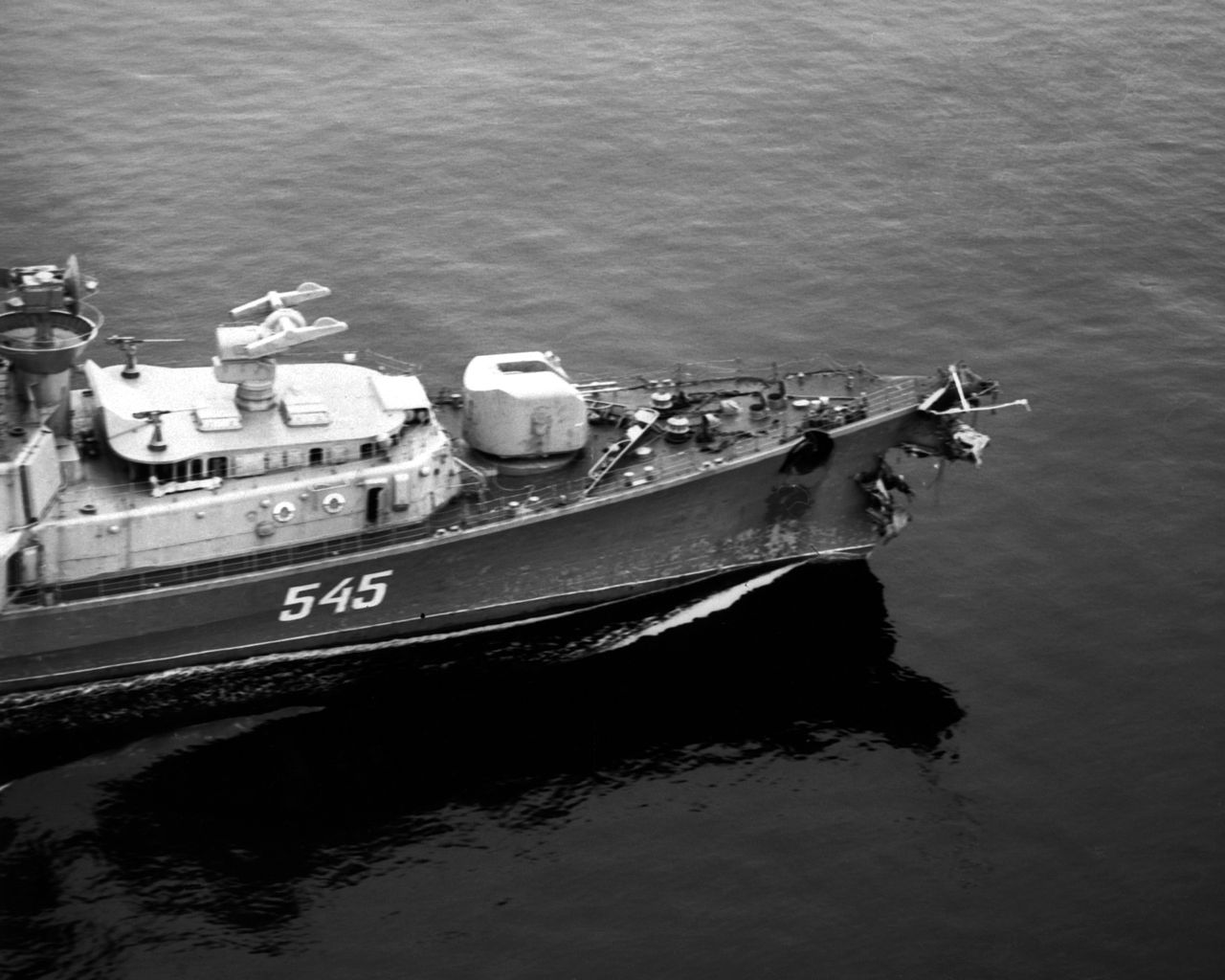
SAN-1 missile launcher, close view, on a Kashin class DD.
ASW armament of the Kynda class
The ASW defense revolved around two triple banks of acoustic torpedo tubes, plus two RBU 6000 rocket launchers (12 rockets each), reloaded vertically, and weighing 3.1 tons. Each 213 mm rocket weighted 75 Kgs and were given a 23 kgs HE warhead. The RSL-60 had rocket weighted 113 kg and could hit submarines underwater raging from 15 to 450 m. All 12 rockets were fired in 5 seconds. It was automatically adjustable, exploding with a magnetic fuse by proximity. For aiming, coordinates were managed by an electronic console, taking its information from the hull’s sonar. The ASW command was given to the Storm firing control system and the firing range was 300-5800 m. Classic depth charges were also carried. Given the very modest range of detection of the sonar Hercules-2 GAS, the RBU-6000 was quite sufficient to deal with modern nuclear submarines. This was complemented by a Kamov Ka-25 “Hormone” helicopter parked on the stern deck spot. However there were no hangar limiting its operations in the north sea and arctic.
Ak-726 guns
The artillery was initially planned to be two dual purpose AK-726 universal twin mounts aft according to the early linearly blueprint scheme. This became at that time the standard medium-caliber system, mainstream in the fleet in the 1960s. It was developed by TsKB-7 in 1957-1958, passed all to be accepted in service in 1962. Therefore the Project 58 cruisers were the first to inaugurate these.
Each mount had two 76.2 mm automatic guns placed in a common cradle, in a lightly armored turret. Rate of fire was 90 rounds per minute, per barrel, so 180 in all. However continuous fire was limited to 45 rounds, in order to watercool the barrels. Each shell weighted 5.9 kg and can reach 15.7 km total or 11 km in ceiling. Each turret weighted 26 tons. However this was limited by the single installation of a MP-105 system controlling it. Therefore the two turret could only concentrate on one same target at a time. In addition to air defense small ships could be effectively destroyed (like fast attack crafts) by the AK-726. Jet aircraft however were still a threat to the ships as the rate of fire an guidance were limited, and the projectile too light to do serious damage.

Admiral Fokin circa 1995, a ship of the Kynda class. The photo shows the huge anti-ship missile ramps and their reloading hangars whose hatches are visible behind.
Active service of the Kynda class
The four Kynda class ships were laid down at Zhdanov shipyard in 1960-61 and completed in 1962-65, then classified as missile cruisers (RKR). The class comprised the Grozny, Admiral Fokin, Admiral Golovko, and Varyag. The latter served in the Baltic Sea, the Golovko in the Black Sea fleet, and the other two in the Pacific. Due their small sizes and many limitations the arctic was not provided such ship indeed. In 1990, they were still active, even if they had been long eclipsed by more formidable ships like the Slava class, designed for the same purpose. They were removed from service in 1990, 1991, and 1993 respecively.
Grozny
The “Terrible” after entering service, took her first commission of the Northern Fleet. She was based in Severodvinsk (Baltic) from July 6, 1962. On July 22, N. S. Khrushchev assisted to the successful launch of two her her P-35 anti-ship missiles. The same year she undertook many further tests in the Baltic, second stage. Nex year, by August 10, 1963 she joined the naval base of Severomorsk where she would be based permently. On July 25, 1965 she took part in a large naval parade in Leningrad, for ‘Navy Day’, and was first introduced to the Soviet public. NATO already had some knowledge of her, giving them the name “Kynda class” for which they are known in Western litterature.
By September 20, 1966, she changed affectation to Sevastopol, joining Black Sea Fleet. She made many cruises in the Mediterranean, visited several ports. In 1968 she participated in the movie “Neutral Waters” (1969), playing the ficticious cruiser “Prideful”. From 1976 to 1982, she was modernized and overhauled at the Sevmorzavod Yard of Sevastopol. Grozny received a brand new new electronic, suite, and four ZAK AK-630M fully automatic anti-missile, close range 30 mm Gatling style guns. In June-September 1982 she was part of the multinational force off the coast of Syria that kept a watchful eye on the the Lebanon war. She provided support to the Syrian armed forces.
By December, 26, 1983 she returned to the Baltic Fleet. She participated in intense combat training, and returned in the Mediterranean Sea in 1985−1986. She was sjadowing American aircraft carrier groups. By April 1989 she was being overhauled and maintained at the shipyard No. 29 in Liepaja hwever work progressed slowly and by the mid-1990 it ceased. As USSR desintegrated, attempts to tow her to Kaliningrad were forbidden by the new Latvian authorities. by July 9, 1991, Grozny was discarded from the lists but stayed, rotting, at the berth of the yard, and eventually sank in March 1993. She had been completely stripped of equipment by the locals, and was later raised by the Latvians and sold as scrap metal.
Admiral Fokin
After entry into service, Fokin joined the Pacific Fleet, taking commission in the summer of 1965 while on the Northern Sea Route. She served in the Pacific and Indian Ocean but was never upgraded and on June 30, 1993 she was discarded and transferred for disposal, to be latter scrapped.
Admiral Golovko
Golovko entered service with the Northern Fleet. However by June 1967 she served in the Mediterranean, assisting the armed forces of Egypt against Israel (six days war). On 22 March 1968 she was transferred to the Black Sea Fleet to be closer to action. In 1982-1989, she was modernization at Sevmorzavod in Sevastopol along the same line as the Grozny. She was discarded from the fleet’s lists in December 2002 and scrapped in Inkerman in 2003-2004.
Varyag
Varyag (“Varangian”, the old Rus and Viking guards of Byzantine emperors) served with the Pacific Fleet. She also made trips in the Indian Ocean and during the third Indo-Pakistani war, under the command of Captain Andrei Andreyevich Pinchuk and her naval group, she kept afar the nearest US Navy Task Force, to intervene on the side of Pakistan. By 1975-1981, she was modernized at Dalzavod (Vladivostok) her radio equipments and electronics being partially replaced and four ZAK AK-630M installed. By 19 April 1990 se was discarded, transferred for disposal and scrapped afterwards.
Evaluation of the project 58 missile cruisers
They were the first Soviet missile cruisers and innovated on many points, bringing a considerabe asset to the fleet as “carrier-killers”. They were a completely revolutionary design, with a very powerful armament, ensuring the success of her combat missions. However she was also far too small, rocky and not agile, yet cheap for their significant combat potential.
Her drawbacks were many: A weak protection against air attacks (two planes could significantly harm her), and compounded to this, the Kynda class were given a slow-firing Volna air defense system, with a primitive single-channel guidance, also only capable to deal with a single aircraft at a time and with an insufficient rang. She also had constructive protection. Many vital command organs were left unprotected.
Another problem were the eight combat-ready missiles due to, again, limited guidance of 4 remote control systems. Volley were to be successive, reducing hit probability while passing air defense, or “wasting” the second volley simultaneously in homing guidance, in the hop to saturate defenses. Reloading proved inefficient and too risky and so a second wave of volleys out in the open sea was virtually impossible. Also the ships were distributed along three fleets, and could not be at sea anytime or support themselves in case of a of an enemy concentration.

Author’s illustration of the Kynda
Specifications of the Kynda class
Displacement: 4400t, 5600t FL
Dimensions: 141,7 x 16,8 x 5,30m
Propulsion: 2 propellers, 2 turbines, 4 chau HP., 100,000 hp. et 34 knots max.
Crew: 390
Electronics: Radars: 2 Don-2, 2 Head-net A/C, 2 Scoop Pair, Peel group, Owl Screech, 2 Plinth net, sonar Herkules, 3 CME Bell, 4 Top hat.
Armament: 2×4 LM SSN3 (16), 1×2 LM SAN1 (16), 4 canons de 76 mm (2×2), 6 TLT 533 mm (2×3), 2 LR ASM RBU 6000 (24).

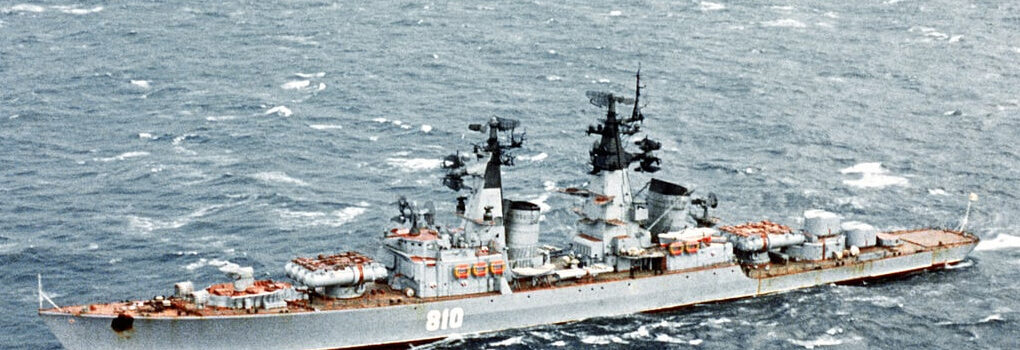
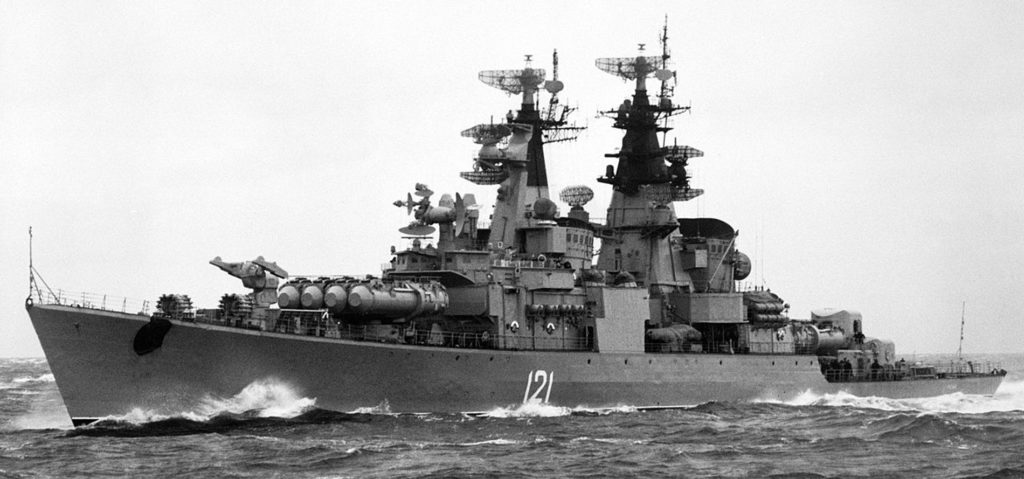
 Latest Facebook Entry -
Latest Facebook Entry -  X(Tweeter) Naval Encyclopedia's deck archive
X(Tweeter) Naval Encyclopedia's deck archive Instagram (@navalencyc)
Instagram (@navalencyc)





 French Navy
French Navy Royal Navy
Royal Navy Russian Navy
Russian Navy Armada Espanola
Armada Espanola Austrian Navy
Austrian Navy K.u.K. Kriegsmarine
K.u.K. Kriegsmarine Dansk Marine
Dansk Marine Nautiko Hellenon
Nautiko Hellenon Koninklije Marine 1870
Koninklije Marine 1870 Marinha do Brasil
Marinha do Brasil Osmanlı Donanması
Osmanlı Donanması Marina Do Peru
Marina Do Peru Marinha do Portugal
Marinha do Portugal Regia Marina 1870
Regia Marina 1870 Nihhon Kaigun 1870
Nihhon Kaigun 1870 Preußische Marine 1870
Preußische Marine 1870 Russkiy Flot 1870
Russkiy Flot 1870 Svenska marinen
Svenska marinen Søværnet
Søværnet Union Navy
Union Navy Confederate Navy
Confederate Navy Armada de Argentina
Armada de Argentina Imperial Chinese Navy
Imperial Chinese Navy Marinha do Portugal
Marinha do Portugal Mexico
Mexico Kaiserliche Marine
Kaiserliche Marine 1898 US Navy
1898 US Navy Sovietskiy Flot
Sovietskiy Flot Royal Canadian Navy
Royal Canadian Navy Royal Australian Navy
Royal Australian Navy RNZN Fleet
RNZN Fleet Chinese Navy 1937
Chinese Navy 1937 Kriegsmarine
Kriegsmarine Chilean Navy
Chilean Navy Danish Navy
Danish Navy Finnish Navy
Finnish Navy Hellenic Navy
Hellenic Navy Polish Navy
Polish Navy Romanian Navy
Romanian Navy Turkish Navy
Turkish Navy Royal Yugoslav Navy
Royal Yugoslav Navy Royal Thai Navy
Royal Thai Navy Minor Navies
Minor Navies Albania
Albania Austria
Austria Belgium
Belgium Columbia
Columbia Costa Rica
Costa Rica Cuba
Cuba Czechoslovakia
Czechoslovakia Dominican Republic
Dominican Republic Haiti
Haiti Hungary
Hungary Honduras
Honduras Estonia
Estonia Iceland
Iceland Eire
Eire Equador
Equador Iran
Iran Iraq
Iraq Latvia
Latvia Liberia
Liberia Lithuania
Lithuania Mandchukuo
Mandchukuo Morocco
Morocco Nicaragua
Nicaragua Persia
Persia San Salvador
San Salvador Sarawak
Sarawak Uruguay
Uruguay Venezuela
Venezuela Zanzibar
Zanzibar Warsaw Pact Navies
Warsaw Pact Navies Bulgaria
Bulgaria Hungary
Hungary

 Bundesmarine
Bundesmarine Dutch Navy
Dutch Navy Hellenic Navy
Hellenic Navy Marina Militare
Marina Militare Yugoslav Navy
Yugoslav Navy Chinese Navy
Chinese Navy Indian Navy
Indian Navy Indonesian Navy
Indonesian Navy JMSDF
JMSDF North Korean Navy
North Korean Navy Pakistani Navy
Pakistani Navy Philippines Navy
Philippines Navy ROKN
ROKN Rep. of Singapore Navy
Rep. of Singapore Navy Taiwanese Navy
Taiwanese Navy IDF Navy
IDF Navy Saudi Navy
Saudi Navy Royal New Zealand Navy
Royal New Zealand Navy Egyptian Navy
Egyptian Navy South African Navy
South African Navy






























 Ukrainian Navy
Ukrainian Navy dbodesign
dbodesign
A bit about P-35 missile and how it’s worked: it have two launch modes, ship-controlled one and autonomous one.
1) In ship-controlled mode, after launch, missile climbed to pre-programmed cruise altitude, and went under control of ship’s radio-command system. The operator tracked the missile flight with the ship’s radar, and could send “right” and “left” commands to alter the missile course. For that, the missile should stay above horizon, of course.
When the missile came near the target, the active radio seeker powered up, and started to scan the area. The radar images from the seeker were retransmitted onboard the ship. Operator saw on his scope what the missile saw, and could manually discriminate the targets and lock the missile on the chosen enemy ship. The missile then dive to 300 ft altitude, and attack target from the steep dive.
2) In autonomous mode, the missile received no correction from the ship. It just flew a pre-set course, activated her seeker at pre-set time, and lock on the first target it noticed. Generally it was less effective mode, because those 1950s electronic brains weren’t very bright, and missile in autonomous mode could be easily fooled.
On the other hands, in the autonomous mode, missile could cruise on much low altitude (because she didn’t need to stay above horizon for the ship).
Also, there were only four fire control channels for the missiles on ship, so the full eight-missile salvo could not be controlled anyway.
3) There was also anti-ground mode, in which operator used missile radar scope to seek & lock on the ground target, and then order the missile into vertical dive on this point. Worked better with nuclear warhead, of course)
Thanks for the precisions Alexey, it’s much appreciated !
Text updated
I hope to dig deeper into Soviet-era missiles in the future.